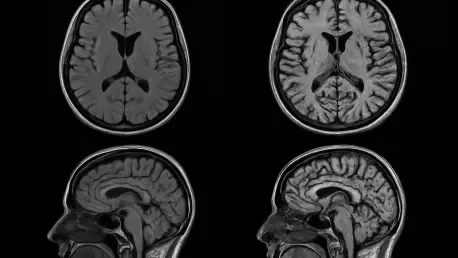Picture a healthcare landscape where a routine MRI scan does more than diagnose current ailments—it predicts how fast each organ in the body is aging and flags potential diseases years before symptoms emerge, transforming the way we approach preventive care. This revolutionary capability is no longer a distant dream but a tangible reality driven by Magnetic Resonance Imaging-based Biological Age Gaps (MRIBAGs), or “MRI age clocks.” These tools, developed for seven key organs including the brain, heart, and pancreas, are poised to redefine aging research and personalized medicine. As the global population ages, with over 20% of individuals in developed nations projected to be over 65 by 2030, the demand for precise, predictive health technologies is skyrocketing. This analysis explores the market dynamics surrounding MRI age clocks, delving into current trends, data-driven insights, and future projections for their adoption in clinical and research settings.
Unpacking Market Trends in Aging Diagnostics
The Rise of Organ-Specific Aging Metrics
The healthcare technology sector is witnessing a seismic shift toward organ-specific aging assessments, propelled by innovations like MRI age clocks. Unlike traditional biological age markers such as telomere length or epigenetic clocks, which offer a generalized view, MRIBAGs provide detailed insights into the aging trajectories of individual organs. Data from large-scale imaging cohorts reveal that predictive accuracy varies significantly, with brain and heart models achieving correlations of up to 0.77 with chronological age, while abdominal organs like the liver show less precision due to limited data. This disparity signals a growing market niche for refining less-studied organ models, potentially attracting investment in AI-driven imaging analytics over the next few years.
Integration with Multi-Omics for Deeper Insights
Another trend shaping this market is the integration of MRI data with multi-omics analyses, encompassing proteomics, metabolomics, and genomics. Industry reports highlight that associating nearly 3,000 plasma proteins and over 300 metabolites with specific organ aging patterns is creating a wealth of biological data. For instance, creatinine’s link to kidney aging offers a clear biomarker for targeted diagnostics. This convergence of imaging and molecular data is driving demand for advanced bioinformatics platforms, with market analysts projecting a compound annual growth rate of 15% for such integrated solutions from 2025 to 2029, as companies race to develop actionable health insights.
Clinical Adoption and Predictive Power
Clinical adoption of MRI age clocks is gaining traction, fueled by their ability to predict disease onset and mortality risk. Market data indicates strong correlations between specific MRIBAGs and conditions like type 2 diabetes (tied to brain and pancreas aging) and hypertension (linked to heart aging). This predictive capacity is sparking interest among healthcare providers, with early adopters integrating these tools into preventive care protocols. However, regional disparities in technology access and population diversity pose challenges, suggesting a market opportunity for scalable, cost-effective solutions tailored to varied demographics over the coming decade.
Future Projections for MRI Age Clocks in Healthcare
Scaling Precision Medicine Applications
Looking ahead, the market for MRI age clocks is expected to pivot sharply toward precision medicine. Projections suggest that by 2028, routine MRI scans could incorporate aging assessments as a standard feature, driven by advancements in AI and machine learning. This shift is likely to spur partnerships between imaging equipment manufacturers and software developers, creating a robust ecosystem for personalized health interventions. The potential to identify druggable targets, such as those related to cardiometabolic health, further amplifies market interest, although validation of these exploratory findings remains a critical hurdle for widespread adoption.
Enhancing Clinical Trials and Research Efficiency
The application of MRI age clocks in clinical trials, particularly for neurodegenerative conditions like Alzheimer’s, is forecasted to transform research methodologies. By stratifying participants based on organ-specific aging profiles, trial designs can achieve greater precision, reducing costs and improving outcomes. Market analysis predicts a 20% increase in demand for such stratification tools within the pharmaceutical sector from 2025 to 2030. Yet, the need for longitudinal studies to confirm predictive accuracy across diverse cohorts underscores a gap that research-focused firms could target for competitive advantage.
Overcoming Barriers to Market Penetration
Despite the optimism, several barriers could temper market growth for MRI age clocks. High costs of implementation, limited infrastructure in emerging markets, and the need for regulatory frameworks to ensure data fairness are significant challenges. Industry forecasts indicate that strategic investments in training healthcare professionals and developing affordable imaging solutions will be essential. Additionally, expanding validation studies to include underrepresented populations could unlock broader market access, positioning early movers as leaders in this evolving space by the end of the decade.
Reflecting on Market Insights and Strategic Pathways
Having delved into the transformative potential of MRI age clocks, this analysis underscores their role in reshaping aging diagnostics and disease prediction. The journey revealed a market ripe with opportunity, from organ-specific aging metrics to precision medicine applications, despite hurdles in data accuracy and accessibility. Moving forward, stakeholders have carved out actionable strategies by prioritizing investments in AI-driven model refinement and cross-population validation studies. Collaborations between tech firms and healthcare providers emerged as a vital step to democratize access, while regulatory advocacy ensured ethical deployment. These efforts laid the groundwork for a future where predictive health tools become integral to extending not just lifespan, but healthspan, across global markets.









